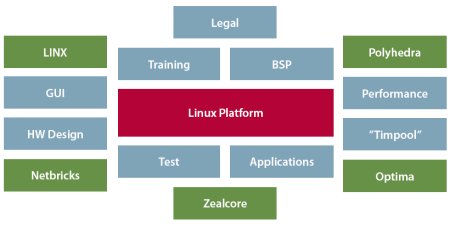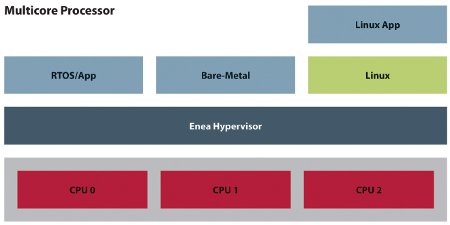Linux build software targets multicore SoCs
Apr 30, 2010 — by Eric Brown — from the LinuxDevices Archive — 2 viewsSweden telecom software firm Enea released improved first-quarter financials this week, also announcing a variety of industry partnerships on multicore technology. Enea's new collaborations include multicore-related initiatives with Freescale and Netlogic Microsystems, the latter involving a joint Linux SDK for Netlogic's MIPS-based XLP, XLR, and XLS processors, according to Enea.
Enea's first quarter 2010 results have improved compared with 1Q 2009, when Enea showed a loss, says the company. Enea's operating margin amounted to 6.3 percent, and profit before tax reached SEK (Swedish Kronar) 11.9 million ($1.63 million US), says Enea.
Net sales were said to have fallen 10 percent to SEK 186.3 ($207.3) million, as a result of a reduction in delivery capacity within the consulting unit. The core software business unit, however, "demonstrated positive development over the quarter, with greatly improved profitability," says Enea. This year the company expects to demonstrate "stable income development and a considerably improved operating profit."
Netlogic Microsystems deal focuses on Linux SDK
Enea announced it has expanded its relationship with NetLogic Microsystems, which acquired RMI Corp. last year, along with its Linux-ready, MIPS64-based XLP, XLR, and XLS multicore, multithreaded processors. Enea has already built and delivered a Linux development environment based on the Enea Linux Project Framework (ELPF) embedded Linux build service for NetLogic's Linux-based software development kit (SDK), says the company (see diagram below).

Major Enea Linux Project Framework (ELPF) accessible components
The SDK will be available free to NetLogic Microsystems customers, backed up by optional commercial support from Enea. The company has also promised support for the SoCs with its OSE Multicore Edition real-time operating system (RTOS).
The first XLP processor, NetLogic's XLP732, was unveiled last May. This superscalar, 40nm-fabricated addition to its family of multicore MIPS64-based system-on-chips (SoCs) is said to support both data- and control-plane processing.
The XLP832 can mix eight "EC4400" cores clocked at 500MHz to over 2GHz, and offers three times the performance per Watt of its previous XLR SoCs, which were introduced in 2005, claims NetLogic. The XLR also integrate four or eight MIPS64 cores, but each is clocked at only 1.5GHz, and they lack superscalar capability.
The lower end of the product line is represented by the XLS family, including the XLS208 SoC introduced in 2008. The XLS208 offers dual 1GHz cores, and like the other Netlogic XLx processors, comes with a Linux-compatible evaluation board and software development kit (SDK).
Enea also announced this week that it has joined the Ensemble Multi-Core Alliance, an industry group backed by Netlogic Microsystems. The Ensemble alliance aims to foster collaboration on software development for multicore parallel processing platforms in networking and telecom applications.
Freescale deal targets QorIQ
As we reported earlier this week, Enea is expanding its strategic relationship with Freescale by providing a OSE-based multi-core software platform for network communications. The platform targets Freescale's QorIQ, PowerQUICC, and Starcore DSP processors, say the companies.

Enea Hypervisor simplified architecture
Also included in the Freescale partnership is support for Freescale's MSC825x DSP family from Enea OSEck, the DSP-optimized version of OSE. The DSP will also be supported by Linx, as well as the Linux-compatible Enea Optima IDE, says Enea.
Enea makes waves in multicore
Enea notes that its products already support multicore processors from ARM, Cavium, LSI, and other semiconductor firms. In another multicore-related announcement involving Enea earlier this week, Texas Instruments (TI) announced Linux kernel support for its TMS320C64x multi-DSP core SoCs, along with a promise by Enea to support it with its Linux-based middleware.
The TI deal appears to involve Enea's telecom-oriented Enea Accelerator Platform, which is designed for IP-based services built on carrier-grade infrastructure. The soup-to-nuts Accelerator integrates a variety of telecom-oriented software, including Linx, and is built on MontaVista or Wind River Linux kernel distributions.
The major component of Accelerator is Enea's high-availability Element middleware, designed for heterogeneous telecom environments that mix Linux with Enea's OSE and OSEck RTOSes. The Element stack's components include event logging, application monitoring, shelf management, and fault management software.
Enea pushed forward on the Linux front last year by announcing the aforementioned ELPF Linux build service. Then in September, it opened an Enea Android Competence Center to provide professional software development services for Android. Earlier this year, Enea announced that Fatskunk is collaborating with the center to develop an Android-based proof of concept prototype on which it can demonstrate its anti-malware technology.
Stated Behrooz Abdi, EVP and GM at NetLogic Microsystems, "Enea is a premier provider of high-performance RTOS and Linux solutions for multi-core processors, and we welcome Enea as a valuable member of the eNsemble Multi-Core Alliance."
Stated Per Akerberg, president and CEO of Enea. "Industry consolidation has opened new opportunities for Enea to strengthen alliances with a number of leading suppliers of multicore processors."
This article was originally published on LinuxDevices.com and has been donated to the open source community by QuinStreet Inc. Please visit LinuxToday.com for up-to-date news and articles about Linux and open source.